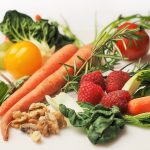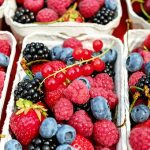Principles of Good Nutrition
The effects of food on health and wellbeing is what nutrition is all about.
Public health nutritionists study the link between diet and disease, and use that knowledge to develop ways to prevent disease in populations.
Dietitians work with individuals to create a nutritional plan based on their specific needs. Treating and managing disease often requires changing one’s diet.
1. Energy
- Energy is needed by the body for a number of functions.
- Energy is provided by the diet (food and drinks) in the form of carbohydrate, proteins, fats and sugars.
- Energy can be measured in either joules (J) or calories (cal). One calorie is equivalent to 4.184 joules or one kilocalorie (kcal) is 4.184 kilojoules (KJ).
- The amount of energy made available to the body by carbohydrates, proteins, fats and sugars varies: per gram of carbohydrate (starch and sugar) provides 16KJ (3.75 kcal), per gram of protein provides 17KJ (4 kcal), per gram of fat provides 37KJ (9kcal), and per gram of sugar provides 29KJ (7 kcal).
- Energy balance occurs when energy intake (food and drinks consumed) equals energy expenditure. An individual in energy balance will maintain their weight. Increases in energy intake/decreases in energy expenditure will lead to weight gain and decreases in energy intake/increases in energy expenditure will lead to weight loss.
- Energy expenditure is primarily determined by body size, body composition and physical activity.
- The actual amount of energy needed will vary from person to person and depends on their basal metabolic rate (BMR) and their level of activity.
- Energy requirements increase by approximately 800 KJ/day in the last trimester of pregnancy, and by about 2100 KJ/day during full lactation.
Weight loss and weight gain come down to one key equation.
Everyone knows this one, though not everyone believes it. It’s the energy balance equation, also known as calories in, calories out (or CICO for short), and it looks like this:
If you consume more calories than you burn, you will gain weight. When you consume fewer calories than you burn, you will lose weight. If you consume the same amount of energy as you expend, you will remain at the same level.
The amount of energy in the body is constantly changing as energy is used up and new energy is taken in. The difference between the amount of energy coming in and the amount of energy going out is what makes up the changes in the body’s energy stores.
Humans can’t create energy from nothing. We convert it from food. Any extra energy you consume doesn’t just disappear: your body either increases how much energy it uses (often by boosting your metabolism) or it stores the excess.
This is the second law of thermodynamics: Energy can be neither created nor destroyed, only transferred from one state to another.
Internal appetite regulation is a game-changing skill… for most people.
Many people use calorie counting as a way to help them make decisions about what and how much to eat. The downside of having an external guardrail is that it can protect against overeating.
If people only follow outside rules, like calorie counts, they may not notice when they’re actually hungry or full.
2. Carbohydrate
- Carbohydrate is needed by the body’s tissues for energy.
- There are two main types of carbohydrates: sugars and starch. Both sugars and starch provide energy.
- Sugars can be subdivided into intrinsic and extrinsic. Intrinsic sugars are those that are part of the cellular structure of foods e.g. sugars in fruits and vegetables. Extrinsic sugars are those that are not part of a cellular structure e.g. lactose in diary products, or honey, fruit juices and confectionary (also known as non-milk extrinsic sugars).
- Complex carbohydrates include starch and non-starch polysaccharides. Starch is found in potatoes, bread, rice and pasta and non-starch polysaccharides are found in fruits, vegetables, legumes and whole-grain cereals.
- Fiber is a type of carbohydrate found only in plants. Fiber cannot be digested so it does not provide energy but is needed for a healthy digestive system.
- At least half the energy in our diets should come from carbohydrate, mostly as starchy carbohydrates.
- Frequent consumption of food and drinks containing non-milk extrinsic sugars can increase risk of tooth decay.
3. Protein
- Protein is needed by the body for growth and repair and is able to provide energy when the diet is low in carbohydrate.
- Protein is found in animal and plant cells in a variety of foods e.g. meat, fish, eggs, dairy, cereals, nuts and pulses.
- Proteins are made up of amino acids. There are approximately 20 different amino acids found in foods.
- Amino acids are broken down into 2 groups: essential and non-essential.
- Essential amino acids are those that must be supplied by the diet: Leucine, Isoleucine, Valine, Threonine, Methionine, Phenylalanine, Tryptophan, and Lysine. Histidine is an essential amino acid for children (not adults) because children are unable to produce enough to meet their needs.
- Non-essential amino acids are those that the human body is able to make itself (by breaking down amino acids in protein that are eaten and absorbing them to make other proteins in the body).
- Different foods contain different amounts and combinations of amino acids.
- Vegans and vegetarians can get all the protein they need by combining different plant sources of protein, e.g. pulses and cereals.
Protein is an important macronutrient to get right
It helps you eat less, without feeling so hungry. Research consistently shows that protein helps you feel full longer and, as a result, lose weight.
This is because it takes the body longer to break down protein than it does carbs or fat. Protein also encourages the gut to produce hormones that make you feel full. When you eat protein, you will eat less because it is natural.
And it makes a big difference. If you double your protein intake, you might eat 400 fewer calories each day without even trying. Roughly, that is the number of calories in 1 and a half cups of ice cream.
Protein makes it easier to build and maintain muscle.
Without adequate protein, our bodies just can’t function well. Without amino acids, our bodies would not be able to create the important molecules that we need for proper function.
If we don’t consume enough protein, our bodies will get it from other places, like our muscles, which will cause muscle loss. If we’re eating fewer calories than we’re burning, this is especially true.
A high-protein diet appears to result in more muscle gain for people who strength train and consume enough calories.
4. Fat
- Fat is needed by the body for energy, for providing essential fatty acids, and for carrying and absorbing fat-soluble vitamins (A, D, E and K).
- Fat is found in meat/meat products, dairy products, fish, eggs, fruit, vegetables, nuts, cereals and cereal products (including cakes and biscuits), savory snacks and oils.
- Fats are described as either saturated or unsaturated depending on the proportions of fatty acids present. Butter is described as a saturated fat because it has more saturated fatty acids than unsaturated fatty acids. Olive oil is described as an unsaturated fat because it has more mono and polyunsaturated fatty acids than saturated.
- Saturated fats are usually found in animal products and unsaturated fats in vegetable sources. There are exceptions to this rule. Unsaturated fats may be converted into saturated fatty acids by hydrogenation.
- Essential fatty acids (EFAs) are those that must be supplied in the diet because the body is unable to make them. There are two essential fatty acids: alpha linolenic acid (n-3) and linoleic acid (n-6). The body is able to synthesize other fatty acids from these two essential fatty acids.
- Fat should not exceed more than one third of a human being’s energy intake and a high intake of saturated fat can have adverse effects on health.
5. Vitamins
- Vitamins are nutrients that are needed by the body in very small amounts for a variety of functions carried out by the body e.g. co-factors in enzyme activity and antioxidants.
- Different foods supply different amounts of vitamins.
- Vitamins needed by the body include: vitamin A, D, E, K (fat soluble vitamins), C, B1, B2, Niacin, B6, B12, Folate (water soluble vitamins).
- Vitamins, except vitamin D, have to be provided by the diet because the body is unable to make them.
- Vitamin D can be produced by the action of sunlight on the skin.
- Each vitamin is required in different amounts for a number of different processes in the human body.
- The amount of each vitamin needed by the body changes during a person’s lifetime.
Fruit and vegetables reduce disease risk—and may help you lose weight, too.
Produce is a type of whole food that is especially important. Fruits and veggies are full of antioxidants, vitamins, minerals, fiber, and phytonutrients which are all great for your health.
A huge amount of evidence from the past 20 years has shown that consuming more fruit and vegetables can help prevent a wide range of health problems, including diabetes, stroke, heart disease, high blood pressure, and cancer.
By increasing our intake of vegetables and fruits, we could potentially prevent 20% or more of all cancer cases, and avoid 200,000 cancer-related deaths annually.
A growing number of studies suggest that a diet rich in antioxidant and anti-inflammatory foods like fruits and vegetables may decrease the risk of developing neurodegenerative diseases.
In terms of cognitive performance, food is better than supplements. When nutrients are isolated from produce and inserted into capsules, they may lose some nutrients.
Eating lots of fruit and vegetables can help you control your weight. The high fiber and water content of these foods help you fill up on fewer calories. A head of cauliflower has around 150 calories.
6. Minerals
- Minerals are nutrients that are needed by the body for a variety of functions e.g. formation of bones and teeth, as an essential constituent of body fluids and tissues, for nerve function and components of enzyme systems.
- Different foods supply different amounts of minerals.
- Minerals needed by the body include: calcium, magnesium, phosphorus, sodium, potassium, chloride, iron, zinc, iodine, fluoride, selenium, copper, chromium and manganese.
- Each mineral is required in different amounts for a number of different processes in the human body. Some minerals are needed in large amounts (e.g. calcium, phosphorus, magnesium, sodium, potassium and chloride) and others in smaller amounts (e.g. iron, zinc, iodine, fluoride, selenium and copper).
- The amount of each mineral needed by the body changes during a person’s lifetime.
As food processing increases, nutrient density decreases.
Whole foods that have been minimally processed (such as grains, nuts, eggs, and fish) contain a wide variety of vitamins, minerals, phytonutrients (plant nutrients), and zoonutrients (animal nutrients).
Though we’re still unraveling exactly which nutrients do what, a wealth of research consistently points to one resounding conclusion:
It is healthier for humans to consume more whole foods and fewer refined foods.
This is probably because the greater the degree of processing, the higher the likelihood that a food:
- Has lost nutritional value, such as fiber, essential fatty acids, vitamins, minerals, and phytonutrients.
- Has gained additives, preservatives, fillers, sugar, sodium, unhealthy fats, and/or refined starch.
When you compare specific whole foods to their more highly-processed equivalents, it is easier to see how much healthier the whole foods are.
Whole foods that haven’t been processed very much are also high in fiber and/or protein, which are nutrients that make you feel full. Healthy, whole foods tend to be lower in calories than highly processed, refined foods. Having these traits make it easier to control our weight.
7. Water
- Over half the human body consists of water, and regular fluid intake is essential for the correct functioning of the body. For example, it acts as a lubricant for joints and eyes, helps for swallowing, provides a medium in which most reactions in the body occur, helps eliminate waste, helps regulate body temperature.
- The amount of fluid needed varies between people and according to age, time of year, climatic conditions, diet and levels of physical activity.
- Water can be obtained from the direct consumption of water and other drinks (e.g. squash, tea, coffee) and through the consumption of food (e.g. fruits and vegetables).
READ MORE: Fitting In Fitness: How To Make Exercise Part Of Your Daily Life









